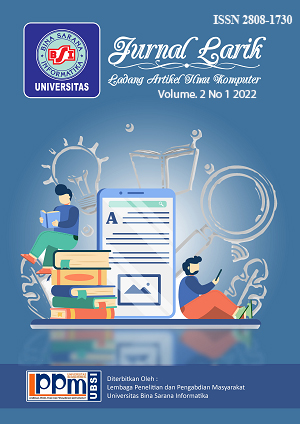Pengembangan Sistem Forecasting Penjualan Pada Aplikasi Point of Sales Menggunakan Metode Trend Least Square
DOI:
https://doi.org/10.31294/larik.v2i1.1153Keywords:
Java, Least Square, Peramalan, Point of SalesAbstract
The use of cash register as evidence of technology utilization in business activities is not enough to help the sustainability of a business, because it has not fully controlled data collection, especially in terms of information about the development of income and inventory planning. Therefore, for the sake of the business sustainability, the strategy is needed, one of which is to build a system that can manage the transaction process equipped with sales forecasting features that can display product predictions according to market needs. To build a system of data collection techniques, the waterfall system development model and the implementation of the Least Square trend method. Of the three research methods that are applied, the contribution produced is in the form of a desktop-based Point of Sales (POS) system with Java programming languages equipped with additional features, namely sales prediction. Based on the application of the system it is proven that the use of the Trend Least Square method is very appropriate to use because it can display the prediction results of sales for the coming period with predictive error rates of only 0.0067% and this system also helps optimize service activities to customers and can help sales management in terms of Provision of products.
References
K. Sari, F. Adrian, and Y. Farradia, “ANALISIS PENDEKATAN BEHAVIORAL INTENTION PADA MINAT MENGGUNAKAN MOBILE PAYMENT OVO,” J. ONLINE Mhs. Bid. Manaj., vol. 5, 2020.
J. Shadiq and R. W. Ratu Lolly, “Sistem Informasi Kasir pada Restoran Siap Saji FoodPanda Berbasis Desktop,” Inf. Manag. Educ. Prof. J. Inf. Manag., vol. 5, no. 1, p. 85, 2020, doi: 10.51211/imbi.v5i1.1444.
D. Wijayanti, S. A. Irawan, E. Haryadi, Y. Komalasari, and D. Mustomi, “Rancangan Aplikasi Kasir Berbasis Dekstop Pada Toko Citra MJ Cikarang,” Bina Insa. Ict J., vol. 8, no. 2, p. 136, 2021, doi: 10.51211/biict.v8i2.1550.
Y. Handoko Agustin, A. Latifah, and A. F. Nugraha, “Perancangan Sistem Informasi Aplikasi Kasir pada Kafe Restorasi Kopi Berbasis Web,” J. Algoritm., vol. 18, no. 1, pp. 302–312, 2021, doi: 10.33364/algoritma/v.18-1.947.
Awanda Ardaneswari and Eko Sediyono, “Pemanfaatan Aplikasi Point of Sales Untuk Prediksi Stock Barang Dengan Metode Fuzzy Tsukamoto,” J. Komput. dan Inform., vol. 15, no. 1, pp. 238–249, 2020.
E. Magdalena Sipayung, C. Fiarni, and Wawan, “Evaluasi Penggunaan Aplikasi Point of Sale Menggunakan Technology Acceptance Model pada UMKM,” J. Nas. Tek. Elektro dan Teknol. Inf., vol. 9, no. 1, pp. 18–24, 2020, doi: 10.22146/jnteti.v9i1.116.
M. Siddik and S. Samsir, “Rancang Bangun Sistem Informasi Pos (Point of Sale) Untuk Kasir Menggunakan Konsep Bahasa Pemrograman Orientasi Objek,” JOISIE (Journal Inf. Syst. Informatics Eng., vol. 4, no. 1, p. 43, 2020, doi: 10.35145/joisie.v4i1.607.
R. T. Prastiti, D. S. Rusdianto, and M. T. Ananta, “Pengembangan Sistem Pengelolaan Transaksi Keuangan dan Persediaan Barang Toko Kosmetik Berbasis Desktop (Studi Kasus: Rumah Melati Bandung),” J. Pengemb. Teknol. Inf. dan Ilmu Komput., vol. 3, no. 5, pp. 5033–5041, 2019.
A. Firmansyah, M. I. Wahyudin, and B. Rahman, “Penerapan Metode Data Mining Pada Point of Sale Berbasis Web Menggunakan Algoritma Apriori,” J. Media Inform. Budidarma, vol. 5, no. 3, p. 1158, 2021, doi: 10.30865/mib.v5i3.3085.
R. Solin, N. I. Syahputri, and A. Budiman, “Metode Least Sequare Dalam Memprediksi Penjualan Sepeda Motor Second,” Semin. Nas. Teknol. Inf. dan Komun. Ke-7, vol. 1, no. 1, pp. 372–381, 2020.
F. R. Dewi, I. N. Farida, and N. Shofia, “Implementasi Metode Least Square dan Weighted Moving Average Untuk Menganalisis Jumlah Kunjungan Wisatawan,” vol. 4, no. 01, pp. 81–88, 2021.
R. M. Fauzi and D. I. Mulyana, “Implementasi Data Mining Menggunakan Metode Least Square untuk Memprediksi Penjualan Lampu LED pada PT . Sumber Dinamika Solusitama,” J. Sos. dan Teknol. ( SOSTECH ), vol. 1, no. 8, pp. 907–919, 2021.
M. Hatta and A. Fauziah Fitri, “Sistem Prediksi Persediaan Stok Darah Dengan Metode Least Square Pada Unit Transfusi Darah Studi Kasus PMI Kota Cirebon,” J. Ilm. Ilmu Komput., vol. 6, no. 1, pp. 41–45, 2020, doi: 10.35329/jiik.v6i1.130.
R. S. Pressman and B. R. Maxim, Software Engineering: A Practitioner’s Approach. In McGraw-Hill Education (Eighth, Vol. 8)., 8th ed. New York City: McGraw-Hill Education, 2015.
A. Ridwan, A. Faisol, and F. Santi Wahyuni, “Penerapan Metode Least Square Untuk Prediksi Penjualan Berbasis Web Pada Doni Sport Malang,” JATI (Jurnal Mhs. Tek. Inform., vol. 4, no. 1, pp. 129–136, 2020, doi: 10.36040/jati.v4i1.2745.




